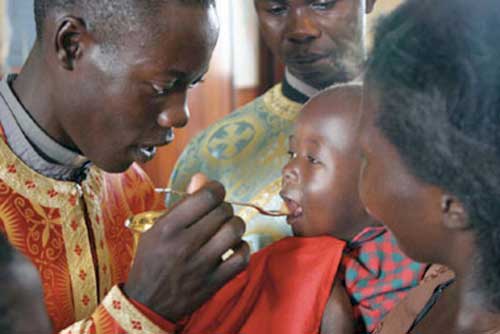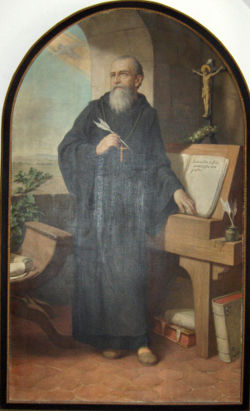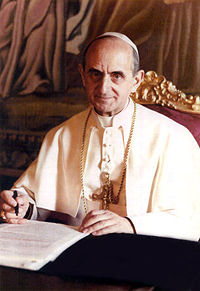
Recent discussion about confirmation (and here and check the search box for more) has highlighted that many people are not aware of the majority historical practice of a united Christian initiation: baptism-christmation/confirmation-communion. Receiving communion, then, is clearly the repeatable part of Christian initiation. Current practices separating baptism; confirmation; communion – or – baptism; communion; confirmation struggle to fit with that tradition. There is also a marked tying together of confirmation with catechesis (so that confirmation becomes a sort of graduation ceremony at the end of a course). Ongoing education and formation in faith is a lifelong process.
Within this discussion, it is helpful to reread the essay, The Liturgy in the Life of the Church by Archimandrite Robert Taft SJ, retired professor from the Pontifical Oriental Institute in Rome. Here is an extract:
A final example is the question of giving Holy Communion to infants who have not yet reached the “age of reason”. Here again, it is a question of the constantly reiterated will of the Holy See, resumed in the Vatican II Decree On the Eastern Churches, Sections 6 and 12, that the Eastern Catholics 1) avoid latinization, 2) preserve their own tradition in its purity, and 3) return to their tradition where they have departed from it.
In harmony with this unambiguous will of the Church, the commission preparing the new Code of Eastern Canon Law prepared new legislation restoring the ancient discipline of infant Communion:
The traditional discipline of the Eastern Churches prescribes the communion of newly baptized infants as the completion of initiation. . . The commission has not ignored a problem so important as the communion of neophytes, for which reason it was obliged to reestablish the ancient common discipline by composing a new canon in the following terms: “Sacramental initiation into the Mystery of Salvation is perfected through the reception of the Most Holy Eucharist. Therefore let it be administered as soon as possible after baptism and chrismation with the Sacred Myron, according to the discipline proper to each Church”
This decree has become Canon 697 of the new Code of Canons of the Eastern Churches. This has warmed the hearts of Western Catholic experts on Christian Initiation, who for some time now have been arguing for the restoration of the integrity of the threefold rite of initiation in the Roman rite. Unfortunately, it has met with less than enthusiastic acceptance in some Eastern Catholic communities that long ago abandoned in favor of the Latin discipline the ancient common tradition of infant Communion immediately after baptism and chrismation.
Now, in the case of Christian Initiation, modern historical research and historical reflection have shown that the universal primitive tradition of both East and West viewed the liturgical completion of Christian Initiation as one integral rite comprising three moments of baptism, chrismation and Eucharist, and without all three the process is incomplete. In Christian antiquity, to celebrate initiation without Eucharist would have made about as much sense as celebrating half a wedding would today. For this reason, contemporary Western Catholic experts on the liturgy and theology of Christian Initiation have insisted on the necessity of restoring the integrity of this process which broke down in the Middle Ages.
I expect that some of the Eastern Catholic clergy, educated in Latin seminaries or at least in Latin categories of a previous epoch, are convinced that the practice of infant communion is not “Catholic”—or at least not as Catholic as the Latin practice of delaying first Communion until children have attained the use of reason. Why they might think this is no mystery. The prevailing Latin thesis was that the use of reason was necessary to receive the Eucharist fruitfully. But if this is so, what could be the point of infant Communion?
This problem, too, can be dissipated by a knowledge of the facts. From the beginning of the primitive Church in East and West, the process of Christian Initiation for both children and adults was one inseparable sequence comprising catechumenate, baptism, chrismation (confirmation) and Eucharist. History is unmistakably clear in this matter: every candidate, child or adult, was baptized, confirmed, and given Communion as part of a single initiation rite. This is the universal ancient Catholic Tradition. Anything else is less ancient and has no claim to universality.
For centuries, this was also the tradition of the Church of Rome. In 417, Pope Innocent I in a doctrinal letter to the Fathers of the Synod of Milevis, teaches that infant initiation necessarily includes Communion:
To preach that infants can be given the rewards of eternal life without the grace of baptism is completely idiotic. For unless they eat the flesh of the Son of Man and drink His blood, they will not have life in them.
[Note: From the text, it is obvious that Innocent I is teaching principally that without baptism infants cannot be saved. But the argument he uses from John 6:53, which refers to the necessity of eucharist for salvation, shows he simply took for granted that communion was an integral part of Christian Initiation for infants].
That this was the actual liturgical practice of Rome can be seen, for example, in the 7th century Ordo romanus XI, and in the 12th century Roman pontifical, which repeats almost verbatim the same rule (I cite from the later text):
Concerning infants, care should be taken that they receive no food or be nursed (except in case of urgent need) before receiving the sacrament of Christ’s Body. And afterwards, during the whole of Easter Week, let them come to Mass, and receive Communion every day.
Until the 12th century this was the sacramental practice of the Roman Church and the doctrinal teaching of Latin theologians. Christ Himself said in John 6:53 that it was necessary for eternal life to receive his Body and Blood—“Unless you eat the flesh of the Son of Man and drink his blood, you shall not have life in you”—and the medieval Latin theologians applied this to everyone without exception, infants included.
The practice began to be called into question in the 12th century not because of any argument about the need to have attained the “age of reason” (aetus discretionis) to communicate. Rather, the fear of profanation of the Host if the child could not swallow it led to giving the Precious Blood only. And then the forbidding of the chalice to the laity in the West led automatically to the disappearance of infant Communion, too. This was not the result of any pastoral or theological reasoning. When the Fourth Lateran Council (1215) ordered yearly confession and Communion for those who have reached the “age of reason” (annos discretionis), it was not affirming this age as a requirement for reception of the Eucharist. Even the 1910 decree Quam singulari issued under Pius X mentions the age of reason not as required before Communion, but as the age when the obligation of satisfying the precept begins.
Nevertheless, the notion eventually took hold that Communion could not be received until the age of reason, even though infant Communion in the Latin rite continued in some parts of the West until the 16th century. Though the Fathers of Trent (Session XXI,4) denied the necessity of infant Communion, they refused to agree with those who said it was useless and inefficacious—realizing undoubtedly that the exact same arguments used against infant Communion could also be used against infant baptism, because for over ten centuries in the West, the same theology was used to justify both! For the Byzantine rite, on December 23, 1534, Paul III explicitly confirmed the Italo-Albanian custom of administering Communion to infants.
So the plain facts of history show that for 1200 years the universal practice of the entire Church of East and West was to communicate infants. Hence, to advance doctrinal arguments against infant Communion is to assert that the sacramental teaching and practice of the Roman Church was in error for 1200 years. Infant Communion was not only permitted in the Roman Church, at one time the supreme magisterium taught that it was necessary for salvation. In the Latin Church the practice was not suppressed by any doctrinal or pastoral decision, but simply died out. Only later, in the 13th century, was the ‘age of reason’ theory advanced to support the innovation of baptizing infants without also giving them Communion. So the “age of reason” requirement for Communion is a medieval Western pastoral innovation, not a doctrinal argument. And the true ancient tradition of the whole Catholic Church is to give Communion to infants. Present Latin usage is a medieval innovation.
The real issue, of course, is not infant Communion, but the universal tradition of the integrity of Christian Initiation, which the West abandoned only in the 12th century. The traditional order of initiation (baptism, chrismation, communion) was maintained until Quam singulari in 1910, when in some countries first Communion began to be given before confirmation. But the Holy See has in the official praenotando of the new Roman Rite of Christian Initiation promulgated May 15, 1969, reaffirmed the traditional order and interrelationship of these rites:
1. Through the sacraments of Christian initiation, men and women are freed from the power of darkness. With Christ, they die, are buried and rise again. They receive the Spirit of adoption which makes them God’s sons and daughters and with the entire people of God, they celebrate the memorial of the Lord’s death and resurrection.
2. Through baptism, men and women are incorporated into Christ. They are formed into God’s people, and they obtain forgiveness for all their sins. They are raised from their natural human condition to the dignity of adopted children. They become a new creation through water and the Holy Spirit. Hence they are called, and are indeed the children of God.
Signed with the gift of the Spirit in confirmation, Christians more perfectly become the image of their Lord and are filled with the Holy Spirit. They bear witness to him before all the world, and work eagerly for the building up of the Body of Christ.
Finally, they come to the table of the Eucharist, to eat the flesh and drink the blood of the Son of Man, so that they may have eternal life and shoew forth the unity of God’s people. By offering themselves with Christ, they share in his universal sacrifice: the entire community of the redeemed is offered to God by their high priest. They pray for a greater outpouring of the Holy Spirit so that the whole human race may be brought into the unity of God’s family.
Thus the three sacraments of Christian Initiation clearly combine to bring the faithful to full stature of Christ and to enable them to carry out the mission of the entire people of God I the Church and in the world.
Thus the Catholic Church has reaffirmed the normative value of the ancient tradition preserved from time immemorial in the East—a renewal received with enthusiasm by all the experts in the field. So both universal early tradition and the present teaching of even the Latin Church show Eastern practice to be not a strange exception that should be abandoned, but the traditional ideal that should be preserved or restored.
If you appreciated this post, do remember to like the liturgy facebook page, use the RSS feed, and sign up for a not-very-often email, …



Hear, hear!
I have to say I’m distressed to learn that some of the Eastern Catholics have abandoned their own tradition in favour of something less authentic.
I can understand the sense that some people might have that communion is such a powerfully divine and transcendent experience that one must meet certain prerequisites before fully deserving it. But as much as I can honor and respect that point of view, it is my own understanding of Christ’s message that all people — ALL — are capable and worthy of salvation. Just as the gift of Grace has no barriers (we all receive it, no matter what), it is my sense that “eat this flesh” and “drink this blood” is a sacrament that is meant for all.
Then again, I’m no expert.
Thanks, Jonathan. To press your point, people can see communion, then, as a reward or as a gift. The same could be understood about God himself. Blessings.
Hi Bosco. Thanks for this timely and interesting piece. I did notice that you focus the comparison on Latin and Eastern Catholicism. I can understand why, but it might be worth mentioning that the Eastern Catholic practice you mention is also that of the Orthodox Churches (Eastern and Oriental), and to the best of my knowledge always has been. The Orthodox are probably a better example as they represent the mainstream or majority Eastern Church (to my mind, at least). The Eastern Catholics are a bit of an historical aberration. Churches that look Orthodox but aren’t really. The Orthodox also don’t have codified canon law (I think that’s correct). They place much more emphasis on canonical tradition and resist tinkering with it. Sorry if this is a bit off-topic, but it kind of ties in…
Not at all off-topic, thanks, Chris. Blessings.
Glad you made the point @Chris Dunn. This is, indeed, common practice in the Orthodox Church. Learned about it while I was studying theology long time ago. I think we in the Western Church could learn a thing or two from our eastern sisters and brlthers.
“to advance doctrinal arguments against infant Communion is to assert that the sacramental teaching and practice of the Roman Church was in error for 1200 years.”
It was. We had a Reformation.
Thanks, Paul. Let me see if I have this correct? You are asserting that for the first 12 centuries of Christian history the church was in error, and the sixteenth-century Reformation was in response to the errors consistently present in those first 12 centuries of Christian history. Your thesis certainly is novel – I look forward to your book, television programmes, and speaking tours. Blessings.